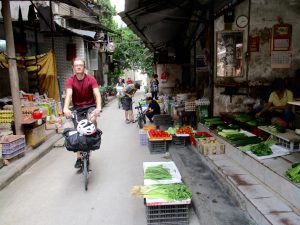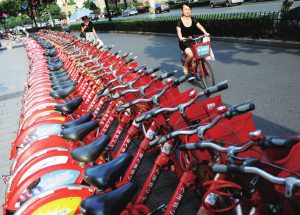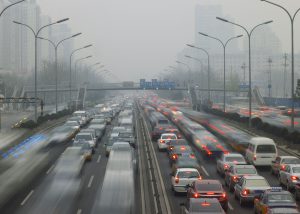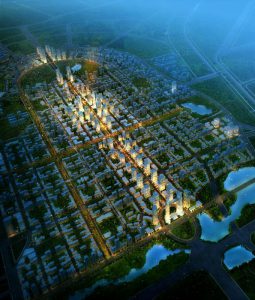Users of electric bikes are the latest target of Beijing’s ongoing campaign to bring order to its chaotic, traffic-clogged streets.
Since April, Beijing’s city government said electric bikes, also known as e-bikes, would be banned from 10 major city centre roads, including Chang’an Avenue, a main thoroughfare, and its side streets.
Users of e-bikes, which are ubiquitous in many Chinese cities, have been penalised for ignoring traffic rules and threatening public safety by mounting kerbs and colliding with pedestrians.
See also: Electric bicycles moving from niche to mainstream
See also: Exporting China’s e-bike marvel
Beijing currently has four million e-bikes, according to media reports.
Transportation authority statistics show 31,404 accidents last year involved e-bikes, with 113 people killed and 21,423 injured, accounting for 37% of all traffic accident injuries.
But critics of the e-bike ban say the government is overreacting, and that better urban planning, such as dedicated lanes for e-bikes, would reduce the number of collisions with pedestrians.
More crucially, experts say a ban on e-bikes would likely boost the sales of cars, which contribute to dangerously high levels of particulate pollution in the capital.
According to research released last year, pollution from vehicles accounts for a third of Beijing’s smog, prompting the city’s government to impose tougher curbs on car use, including plans for a congestion charge.
“If we do away with them (e-bikes) people will have no option but to buy cars, which are larger and polluting, Chou Baoxing, a State Council advisor and former minister for housing and urban-rural development, said in an interview with Caijing magazine.
The car manufacturers would likely benefit, and traffic police will deal with fewer offences, but the city’s environment will suffer, with poorer air quality and increased congestion, Chou added.
He pointed out that e-bikes, which are low carbon and suitable for an ageing population, have a valuable role in China’s sprawling, congested and fast growing cities.
Liu Daizong, head of the World Resources Institute’s China Sustainable Transport project, said that if the ban isn’t accompanied by preferential measures for alternative modes of transport, such as (non-motorised) bicycle and bus lanes, then electric bicycle owners will likely buy cars instead.
He Zuoxiu, a member of the Chinese Academy of Sciences, told chinadialogue that the ban is a test to see how the public reacts. “If there isn’t much opposition, it’s very likely the ban will be extended to other roads, and other cities in China,” he said.
For instance, in Shezhen 18,000 electric bicycles were confiscated in March this year, with 874 people arrested. Confiscated bicycles were piled up below overpasses, in “bicycle graveyards.”
Bike nation
China was once a land of bicycles. In 1994, almost every household owned two bicycles; across the country, there were only 2 million private cars (according to the Chinese Statistical Yearbook). By 2013 the number had shot up to 100 million cars; a 50-fold increase. Today, Beijing alone has 5.61 million vehicles.
And as the traditional-type bicycle fell from favour, e-bikes became more popular. Figures from industry website evtimes.cn show there are 200 million electric bicycle users in China; that’s one in seven people.
Standards
Being more affordable, e-bikes sell better than cars in China and the fastest models sell best.
The most recent e-bike standards were last issued in 1999. These require that e-bikes weigh no more than 40 kilogrammes; go no faster than 20 kilometres per hour; and have foot pedals built-in.
Under current regulations, road authorities can stop and penalise bikes in breach of these standards, with drivers subject to fines (though in reality most go unpunished). However, the public wants to see these outdated standards revamped.
At this year’s “twin sessions” political conference in Bejing, National Representative Zhang Tianren said 95% of electric bicycles failed to meet the 1999 standards. If true, this means that over 100 million e-bikes on the roads aren’t actually legal.
Restrictions on e-bikes aren’t just a matter for commuters – many other sectors are affected, including courier businesses and food deliveries.
Zhang, an e-bike rider at courier company Shentong Express, told chinadialogue that if his speed was limited to 20 kilometres per hour (in keeping with the 1999 standards), he wouldn’t be able to make so many collections and deliveries, damaging his income.
Going national
This isn’t Beijing’s first such clampdown. He Zuoxiu told chinadialogue that over 10 years ago, the car industry lobbied the city government to discourage e-bikes – but widespread opposition meant their efforts were unsuccessful.
Since then, complaints have grown about e-bike users ignoring traffic rules.
With the regulations unclear, these small and manoeuvrable vehicles often switch between bicycle and vehicle lanes and the pavement, slowing down faster-moving cars and intimidating pedestrians and those on traditional bikes.
Divisions of roads into vehicle lanes, bicycle lanes and pavements, which were made decades ago, have failed to keep up with the increasingly diverse modes of transport in Beijing.
“Electric bicycles themselves aren’t evil,” said Liu Daizong, who added that accidents involving cars cause much more harm than other forms of transport.
Offering potential solutions to the problem, Liu said electric bicycles should be categorised according to maximum speed, with driving licences needed to ride faster categories; better allocation of priority on the roads; and strict enforcement of traffic rules.
That way, safety could be improved and the environmental benefits of e-bikes retained in cities that have increasingly tough targets on cutting pollution and carbon.








